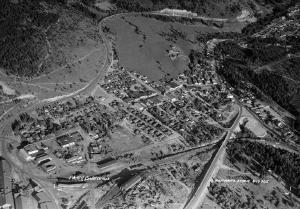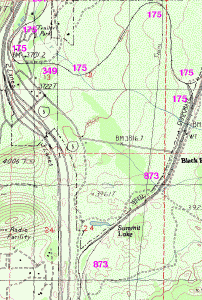Speed-Zone 8:
Black Butte to Edgewood
This section has the same tight curvature as the Sacramento River Canyon. Higher average speeds than in the canyon are a result of the different operating strategy, suggested for the Siskiyou Line and its low amount of freight: More superelevation, more unbalanced superelevation, less buffer time.
The curvature has to be explained by the effort of 1880, to restrict the grade to 2.2%. There were no natural obstacles, which could have outruled a straighter alignment in this roomy valley. By snaking along the curvy sides of the valley, much of the descending could be done without the erection of dams. 25 years later, the sawmill of Abner Weed took advantage of the railroad, and the workers settled in a loop of the track. Long-Bell Lumber Co. made Weed a regional center of railroad operation, with a network of logging railroads around its mill.

Weed in the days of Long-Bell Lumber Co.
While Oregon timber is still the most important load of the daily freight train to Black Butte, the golden days of the industry are over, and with it, the numerous long freights on the Siskiyou Line. Weed defines itself as a retirement community today. Its population has decreased, but due to its history, it is well located in the traffic network. In addition, speed is restricted by the track loop in Weed, reducing the time lost by a stop. Therefore, it is suggested to use Weed as a station again.
